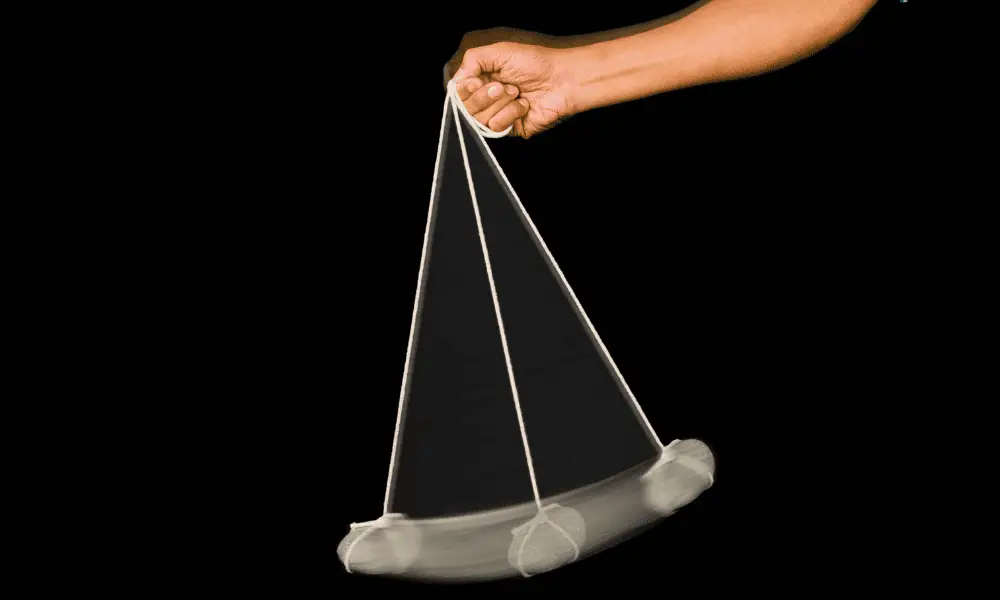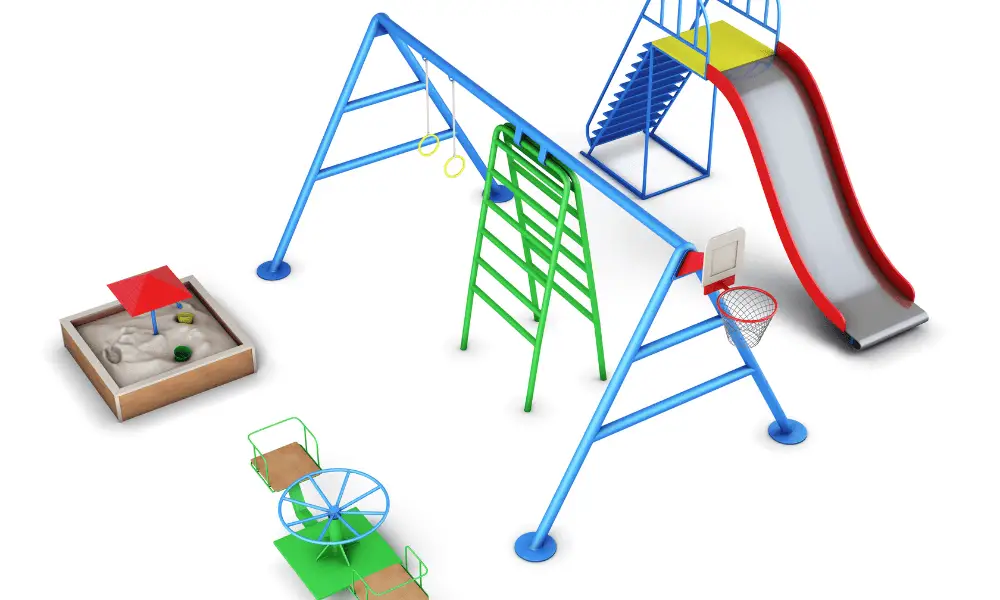Have you ever been on a playground swing, pumping your legs back and forth with the wind in your hair, and wondered just how fast you’re going?
You’re not alone – the speed of playground swings is a question that has intrigued kids and adults alike since their inception.
In this article, we’ll explore the physics behind swing speed, different types of swings that exist, factors that influence their speed, safety considerations to be aware of, and tips for maximizing fun while minimizing risk.
You might think that calculating the speed of a swing would involve complex mathematical equations or expert knowledge in physics.
However, as you delve into this fascinating subject matter further, you’ll discover that it all comes down to some simple principles which can be easily understood using real-world examples and concise explanations.
The Physics Behind Swing Speed

You might not realize it, but the physics behind swing speed plays a crucial role in how fast you’re able to go on those playground swings.
Swing momentum and pendulum principles are key factors that determine your swinging experience. To maximize your swing speed, you’ll want to understand the forces at work and leverage them to your advantage.
The science behind a swing is based on the principles of a simple pendulum, where the only force acting upon it is gravity.
The pendulum’s period (the time it takes for one complete back-and-forth cycle) depends on its length and the acceleration due to gravity; this means that longer swings have slower periods while shorter ones have faster ones.
You can increase your momentum by timing your body movements with the natural oscillation of the swing: as you move forward in sync with the swing’s motion, you increase gravitational potential energy, which then gets converted into kinetic energy as you move downward, thereby increasing your speed.
To further improve your playground swinging skills, try leaning backward during an upswing and forward during a downswing – this small action can make a big difference!
By doing so, you effectively change the center of mass of the system and alter its moment of inertia.
This allows for greater angular momentum conservation throughout each arc of movement – ultimately propelling you higher and faster than before.
So, next time you hit those playground swings, keep these physics concepts in mind. Not only will they help enhance your fun, but also satisfy that subconscious desire for understanding just how things work!
Different Types of Swings

There’s a surprising variety of swing types, each with its own unique motion and thrill factor! Swing materials and innovative designs play a significant role in the speed at which these swings can go.
From classic wooden or rubber seats hanging from sturdy chains to more modern options like tire swings or even saucer swings, there’s something for every adventurous spirit.
For instance, let’s look at tire swings. Not only do they provide an exciting twist on the traditional swing experience with their circular shape and ability to spin, but they also introduce additional factors that affect speed.
The mass and size of the tire can impact both momentum and air resistance, leading to variations in how fast it may travel when given a good push.
On the other hand, you’ve got rope-based swings such as spider-web swings or disc swings that have less material to create wind resistance; thus, allowing them to potentially move faster through the air.
Now let’s explore some interesting numbers using real-world examples. Imagine two different scenarios:
In scenario one, you have a classic wooden swing that weighs 10 pounds (4.5 kg), attached to chains with very little air resistance. Given an initial push force of 20 pounds (89 N), this swing might reach speeds up to 6 miles per hour (9.65 km/h).
In scenario two, you’re enjoying an exhilarating ride on a saucer-swing made of lightweight plastic weighing only 5 pounds (2.25 kg) with similar chain attachments but significantly less wind resistance due to its shape.
With the same initial push force applied here as well, this innovative design could allow you to reach speeds closer to 8 miles per hour (12.87 km/h)!
So next time you’re enjoying your favorite playground pastime, take note of how different types of swings live up to their thrill factor by offering varying speeds based on their materials and designs!
Factors Influencing Speed

It’s fascinating to consider the various factors that influence the speed at which different types of swings can travel, providing thrill-seekers with unique experiences and adrenaline-pumping rides.
Swing materials and the optimal angle are just a couple of components that dictate how fast a playground swing will go. An understanding of these factors can help you maximize your swinging experience or simply satisfy your curiosity about the physics behind it all.
Swing materials play a crucial role in determining speed, as they affect how smoothly and efficiently energy is transferred during motion.
For instance, heavier chains or ropes may cause more friction as they rub against each other, limiting the speed you’ll achieve. On the other hand, lighter materials like nylon ropes have less resistance and allow for smoother movement, which contributes to faster speeds.
In addition to material choice, the length of the swing also comes into play – longer swings cover greater distances while shorter ones boast quicker back-and-forth motions due to their reduced arc lengths.
Another factor worth considering is finding the optimal angle for maximum momentum transfer when kicking off from a stationary position on a swing.
This sweet spot typically falls between 10-20 degrees from vertical (0 degrees being straight up), where riders generate enough force without sacrificing stability or efficiency during motion.
As an example: if you were to push off at 45 degrees from vertical instead – while it might feel more powerful initially – much of that force would be directed horizontally rather than propelling your upward trajectory on the swing itself.
Understanding these elements allows you to optimize your swinging technique and tap into some exhilarating speeds!
Safety Considerations and Guidelines

While soaring high and embracing that adrenaline rush, don’t forget to keep safety in mind to ensure your thrilling escapades remain enjoyable and free from mishaps.
Swing maintenance plays a crucial role in keeping playground equipment safe for use. Regularly inspect the chains and seats for wear and tear, as well as check the structural integrity of the supporting frame.
Additionally, make sure that the ground is clear of debris or objects that could cause injury if someone were to fall off the swing.
Supervision’s importance cannot be overstated when it comes to swinging on playground swings. Adults should closely monitor children while they’re using swings to prevent accidents caused by excessive speed or improper usage.
Encourage kids not to stand on swings or jump off them while still in motion, as these actions can lead to severe injuries.
Furthermore, teach children about proper swinging techniques – including how much force should be applied when pumping their legs – so they can enjoy their time at the playground without going too fast and risking potential harm.
Always remember that having fun on a swing doesn’t mean pushing the limits of speed recklessly; instead, prioritize safety above all else.
By maintaining your swing set properly and providing attentive supervision during playtime, you can minimize risks associated with swinging too fast or improperly using playground equipment.
So go ahead and embrace those exhilarating moments on a swing – just be sure you’re doing so safely!
Maximizing Fun While Minimizing Risk

You can truly maximize the enjoyment of soaring through the air on a swing while minimizing potential risks by following proper safety guidelines and encouraging responsible swinging techniques.
The balance between risk and fun is essential for having a good time at the playground without any unwanted accidents.
By understanding the physics behind swings, as well as some swing variations, you’ll be able to enjoy your time at the park with confidence.
Here are some tips for maximizing fun while minimizing risk:
As you become more comfortable on different types of swings, you may want to explore various swing variations, such as standing up on skateboard-style swings or using rope swings over water.
These alternative options can provide new challenges and excitement while still adhering to safety precautions.
Always remember that getting too caught up in pushing your limits could result in injury; therefore, stay within your comfort zone and prioritize safety above all else when enjoying this timeless childhood activity.
Conclusion
So, you’ve learned a bit about the physics behind swing speed, different types of swings, and factors that can influence how fast you go. Remember, safety comes first!
It’s interesting to note that an average playground swing can reach speeds of around 6 mph. Keep in mind those guidelines to maximize fun while minimizing risk.
As long as you’re careful and mindful of others, feel free to enjoy the thrill of swinging without worrying too much about breaking any speed records. Happy swinging!




